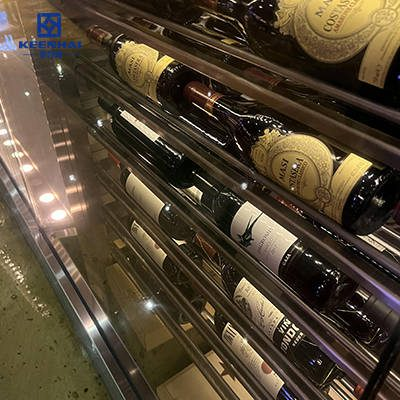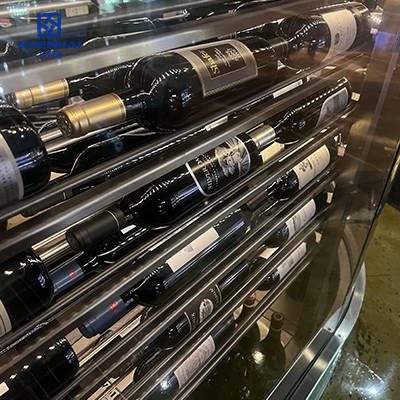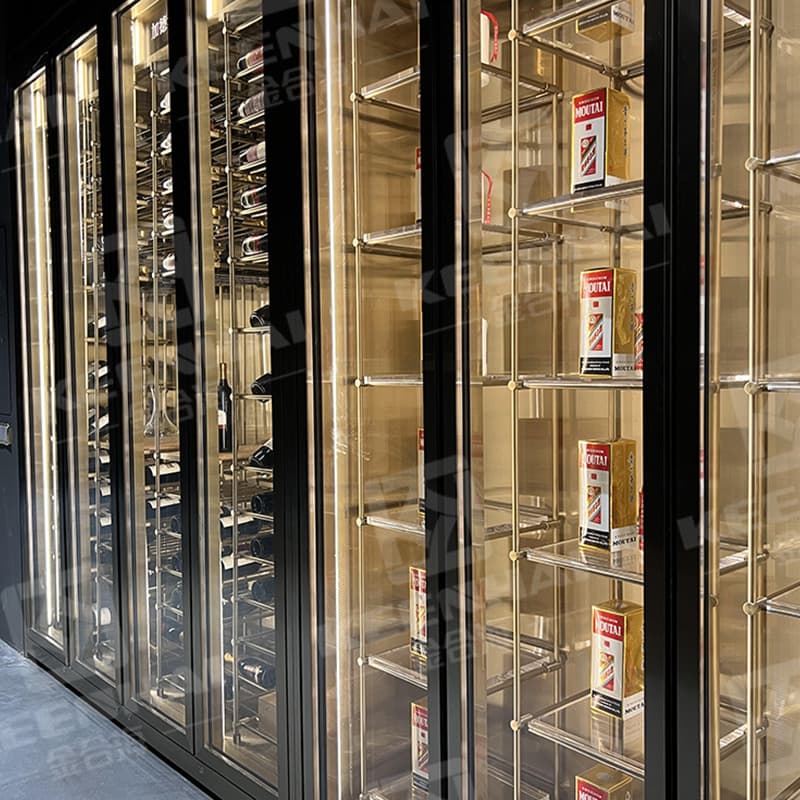Top 2025 wine cellar designs prioritize flexibility and aesthetic appeal. Stainless steel wine cabinets allow for mixed-use storage of reds, whites, and sparkling wines. Paired with glass doors or wood accents, they create visual harmony while maximizing capacity. Efficient temperature zones, energy-saving cooling systems, and organized labeling ensure both functionality and elegance, making the cellar a highlight of modern interior design.
1. Modern Stainless Steel Wine Cellar Layouts
1.1 Open vs. Enclosed Layouts for Home Spaces
Picture a contemporary loft in New York or Milan, where the kitchen and living room share an open space. Open wine cellar layouts allow homeowners to showcase their collection as part of the room’s decor, while enclosed designs provide controlled storage for temperature-sensitive wines. Surveys show that over 55% of urban homeowners prefer open-concept wine displays for both accessibility and aesthetic appeal. That’s why many are choosing a custom stainless steel wine cellar design to integrate style and functionality seamlessly.
1.2 Floor-to-Ceiling vs. Modular Rack Configurations
Maximizing storage in modern homes often requires a choice between floor-to-ceiling racks dan modular wine storage units. Floor-to-ceiling designs offer maximum bottle capacity, ideal for serious collectors, while modular configurations provide flexibility for evolving collections or spatial constraints. Consider the following comparison:
| Ciri | Floor-to-Ceiling Racks | Modular Racks |
|---|---|---|
| Capacity | High (up to 300+ bottles) | Moderate (50–150 bottles per module) |
| Fleksibiliti | Fixed | Highly adjustable |
| Aesthetic | Sleek, uniform look | Customizable, playful patterns |
| Pemasangan | Professional required | DIY possible |
Many modern steel wine displays adopt modular units in urban apartments where space is limited, allowing homeowners to combine wine racks and bar cabinets without sacrificing design cohesion.
1.3 Maximizing Vertical and Horizontal Storage
In contemporary homes, efficiency is key. Vertical stacking saves floor space and creates dramatic visual lines, while horizontal shelving ensures easier bottle access and label visibility. Designers often integrate adjustable stainless steel wine racks to accommodate bottles of different sizes without compromising the sleek aesthetic. Step-by-step installation typically involves:
-
Measuring the intended space precisely.
-
Securing the base frame and verifying level alignment.
-
Installing modular racks and testing load capacity.
-
Adding accent lighting to highlight the collection.
This combination of vertical and horizontal strategies turns a wine storage solution into a functional centerpiece that enhances modern interior design.

2. Material and Finish Options
2.1 Choosing Between 304 and 316 Stainless Steel
When selecting materials for a modern wine cellar, 304 keluli tahan karat is often preferred for indoor use due to its excellent corrosion resistance and cost-effectiveness. 316 keluli tahan karat, on the other hand, offers superior protection against moisture and salts, making it ideal for humid environments or coastal residences. According to construction data, 316 steel resists pitting corrosion 50% more effectively than 304, which is crucial for maintaining a pristine wine storage space over decades. Designers often combine both types in hybrid installations, using 316 for exterior frames and 304 for internal shelving, optimizing both durability and budget.
2.2 PVD Coatings, Brushed, and Matte Finishes
Surface finishing dramatically affects both aesthetics and maintenance. PVD coatings provide long-lasting color options like champagne, black, or bronze while resisting scratches and fingerprints. Brushed finishes give a subtle texture that reduces visible smudges, whereas matte finishes offer a muted, contemporary look that complements minimalist interiors. Compare common finishes:
| Finish Type | Aesthetic | Maintenance | Ketahanan |
|---|---|---|---|
| PVD Coating | Color variety, modern | Easy clean, scratch-resistant | High |
| Brushed | Soft texture, reflective | Moderate | Sederhana |
| Matte | Minimalist, muted | Easy clean | Medium-High |
In urban apartments, modern stainless steel wine displays are often finished in brushed or matte textures to reduce glare under bright LED lighting while maintaining a high-end appearance.
2.3 Integrating Glass, Wood, and Steel Accents
Blending materials enhances both function and style. Glass panels can showcase wine collections elegantly, while wood accents soften the coldness of steel for a warmer ambiance. Many contemporary setups use steel frameworks combined with tempered glass doors to create sleek, transparent storage. Pull-out drawers or integrated lighting further enhance usability. By layering textures, homeowners can highlight each bottle individually, achieving both practicality and visual appeal. Step-by-step integration often involves:
-
Selecting complementary finishes for steel, wood, and glass.
-
Ensuring frame supports match the weight and size of glass panels.
-
Installing accent lighting to emphasize vertical and horizontal bottle alignment.
This approach balances durability, accessibility, and design, making steel wine storage systems feel both luxurious and approachable.
3. Temperature and Climate Control
3.1 Room-Temperature vs. Chilled Wine Zones
A well-designed wine cellar often separates wines by storage temperature. Room-temperature zones maintain reds at 55–65°F (13–18°C), ideal for long-term aging. Chilled zones keep whites, rosés, and sparkling wines at 45–55°F (7–13°C) for optimal flavor. Modern setups sometimes integrate dual-temperature compartments within a single custom stainless steel wine cellar design, allowing homeowners to store multiple varietals efficiently. Surveys indicate that homes with zoned temperature control preserve wine quality 35% longer than single-temperature systems, highlighting the importance of precise climate planning.
3.2 Ventilation and Humidity Management
Humidity control is critical to prevent cork drying or mold growth. Ideal humidity levels range from 55% to 75%. Effective ventilation circulates air without causing temperature fluctuations. Passive solutions include vented cabinets and lattice-style shelving, while active systems use small fans integrated with climate control units. Compare methods:
| Ventilation Method | Humidity Control | Pros | Cons |
|---|---|---|---|
| Passive airflow | Moderate | Quiet, low energy | Less precise |
| Active fans | High | Consistent humidity | Higher energy use |
In modern interiors, combining well-ventilated rak wain keluli tahan karat with precise humidifiers ensures both aesthetic appeal and wine preservation.
3.3 Energy-Efficient Cooling Systems
Energy efficiency is no longer optional in residential wine storage. Thermoelectric cooling units are quiet and cost-effective for small setups, while compressor-based systems handle larger capacities with high reliability. Step-by-step implementation for efficiency:
-
Calculate total wine volume and required cooling capacity.
-
Choose between thermoelectric or compressor-based systems.
-
Install programmable thermostats for zone control.
-
Integrate LED lighting to minimize heat emission.
Using energy-conscious designs with modern steel wine displays not only reduces utility costs but also supports sustainable living without compromising storage quality or style.

4. Lighting and Display Techniques
4.1 LED Strip Lighting for Bottle Highlights
Modern wine storage increasingly relies on LED strip lighting to enhance visibility and create a dramatic effect. Installing flexible LED strips along the racks illuminates bottles without producing heat, preserving wine quality. For example, pairing modern stainless steel wine display with subtle LED highlights can elevate the aesthetic of both residential and commercial cellars. Surveys show that homes using LED-accented wine racks report a 30–40% improvement in label visibility and visitor engagement during tastings.
4.2 Accent and Ambient Lighting Strategies
To create depth, designers combine ambient ceiling lights with focused accent lights on key sections. Adjustable warm-tone LEDs reduce glare while highlighting prized vintages. Compare common lighting strategies:
| Lighting Type | Purpose | Pros | Cons |
|---|---|---|---|
| LED strips | Bottle highlights | Low heat, energy-efficient | May require wiring management |
| Recessed ceiling lights | Ambient illumination | Uniform brightness | Less bottle-specific focus |
| Spotlights | Feature bottles | Strong visual impact | Can produce glare if misaligned |
Using contemporary wine cabinet design principles ensures lighting complements the stainless steel surfaces, enhancing reflection and making collections visually striking without affecting wine stability.
4.3 Label Visibility and Showcasing Collections
Optimal display angles keep labels fully visible while minimizing dust accumulation. Slanted racks with 6–12° tilt for reds and slightly less for whites maximize readability and prevent sediment disruption. Homeowners integrating custom stainless steel wine cellar design often combine modular shelving with LED accents to create dynamic, easy-to-navigate collections. In practical terms:
-
Align racks with eye level for key bottles.
-
Separate zones by varietal or region.
-
Use reflective stainless steel back panels to amplify light without overexposing bottles.
These techniques ensure the wine storage is both functional and visually impressive, blending seamlessly with modern interiors.
5. Custom Features and Accessibility
5.1 Pull-Out Racks and Sliding Drawers
Modern stainless steel wine cellars increasingly feature pull-out racks and sliding drawers, making bottle retrieval effortless while protecting labels from unnecessary handling. These systems are ideal for both casual collectors and serious enthusiasts, as they allow for quick access without disturbing surrounding bottles. For example, a modern steel wine display installed in a Manhattan apartment incorporated pull-out trays for half and full bottles, improving both convenience and aesthetic appeal.
5.2 Modular Shelving for Mixed Bottle Sizes
Wine collections often include bottles of varying shapes, from standard Bordeaux to Champagne magnums. Modular shelving solves this challenge by letting homeowners adjust compartments to fit their inventory. By comparing fixed vs. adjustable layouts, modular systems offer superior flexibility:
| Ciri | Fixed Shelving | Modular Shelving |
|---|---|---|
| Adjustable for bottle size | ❌ | ✅ |
| Ease of adding new bottles | ❌ | ✅ |
| Space efficiency | Sederhana | High |
| Accessibility | Sederhana | High |
This approach ensures every bottle has a secure place while maintaining a clean, modern aesthetic.
5.3 Integrated Tasting Areas and Bar Cabinets
For homeowners who enjoy entertaining, integrating a tasting counter or small bar cabinet enhances both functionality and social appeal. Stainless steel bar cabinets can be incorporated seamlessly into the cellar, providing a sleek, hygienic surface for pouring and serving wine. Combining tasting areas with proper lighting and bottle display elevates the room into a versatile space that is both practical and visually impressive.

6. Design Integration with Modern Interiors
6.1 Coordinating Steel Cellars with Open Kitchens
Integrating a modern steel wine display into an open kitchen enhances both functionality and style. Open-plan layouts benefit from sleek, reflective surfaces that complement stainless steel appliances. Surveys indicate that over 55% of homeowners who install steel wine cabinets in open kitchens report improved traffic flow and a more cohesive aesthetic, as the wine storage doubles as a design centerpiece without obstructing sightlines.
6.2 Blending with Living Room or Dining Room Aesthetics
When positioning a custom stainless steel wine cellar design in living or dining areas, matching furniture lines and color palettes is essential. For instance, brushed steel finishes coordinate seamlessly with neutral-toned wood furniture and muted leather accents, creating a luxurious yet understated focal point. Layering subtle LED lighting accentuates bottles while maintaining harmony with surrounding décor.
6.3 Combining Functionality and Visual Elegance
To maximize both utility and visual impact:
-
Place frequently used bottles at eye level for easy access.
-
Use modular sections to separate reds, whites, and sparkling wines.
-
Include reflective back panels or glass doors to enhance ambient light.
By thoughtfully integrating steel cellars with room aesthetics, homeowners achieve a balance of practicality and elegance. For complete product solutions, exploring pvdstainlesssteel’s portfolio offers modern stainless steel wine cabinets, racks, and bar storage that blend flawlessly with contemporary interiors.





